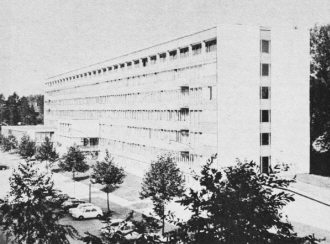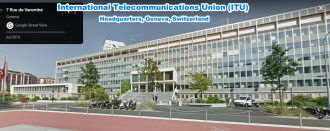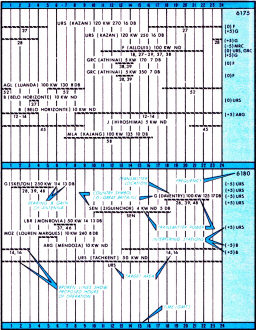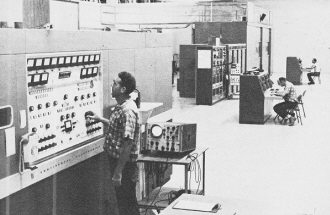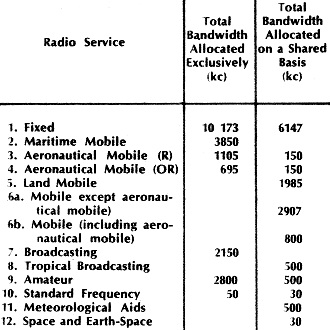The Grim Facts on Short-Wave Broadcasting
|
|
Stanley Leinwoll wrote a couple articles about shortwave broadcasting for the September 1969 edition of Electronics Illustrated magazine. "They're Taking the Guesswork out of Scatter Communications" discusses advances (at the time) in ionospheric scattering of shortwave radio signals, and also this one entitled "The Grim Facts on Short-Wave Broadcasting." This is another example of the old adage of how the more things change, the more they remain the same. Frequency crowding was then and is now a continual challenge for operators in non-privileged bands (spectrum purchased for private, military, government, or commercial use, e.g., cellphone carriers). Mitigation techniques include narrowing of channel bandwidth (via improved modulation techniques or improved transmitter / receiver spectral requirements), decreased transmit power levels, modification of usage regulations, and allocation of new spectrum (either by reallocation of existing bands or opening new bands at the top of existing bands). These issues are not unique to the U.S. or even western Europe; they are problematic for nearly all regions, except for maybe in Siberia, the middle of the African continent, or at the poles. I captured a Google Street View image of the International Telecommunications Union (ITU) headquarters building then (1969) and now (2013). Not much has changed. The Grim Facts on Short-Wave Broadcasting Headquarters for the International Telecommunication Union (ITU) is now located in Geneva, Switzerland. ITU Headquarters in 2013 (Google Maps) - looks pretty much the same as in 1969. Watch it - Your short-wave receiver may soon be gathering dust! By Stanley Leinwoll Talk to a ham licensee and the first thing he'll complain about is the decreasing space available on the ham bands. He has lost quite a bit of the spectrum over the last few years and he's anxious about the future. Most short-wave listeners, however, seem to live in a land of milk and honey. As they tune in stations all over the globe they seldom question what the future will bring. Local conditions are blamed for interference and, of course, increased transmitter power would take care of a lot of things. Or would it? Truth is, time is running out for short-wave broadcasting. Unless something is done pronto by the powers that be, your SW receiver soon may sound like a voice scrambler in Operations at the Pentagon. A traffic jam is building up all over the spectrum that will soon make your Sunday afternoon drive look like a breeze. Unfortunately, unlike cars, most radio waves don't travel in the nice, neat patterns found on the highway charts of a city planner. Directional antennas are a help but radio propagation dictates that a good deal of energy will always spread to areas where it isn't wanted. And the more transmitters in a given area, the more likely that interference will be severe. Geneva. Of course, this problem isn't new. September marks the tenth anniversary of the Geneva Radio Conference where representatives from almost 100 countries made the first attempt to bring law and order to the management of international high-frequency broadcasting. Up until this conference very little had been done to plan the flow of radio transmissions throughout the world. At Geneva, a revolutionary new procedure - described in Article X of the Geneva Radio Regulations of 1959 - was drafted which brought some stability to international broadcasting at a time when it appeared headed towards complete turmoil. Fig. 1 - A page from March 1969 tentative schedule published by the International Frequency Registration Board (IFRB) in Geneva, Switzerland. Here you can see broadcasting plans of various countries for two frequencies. 6175 and 6180 kc. Information is identified in color. However, the conditions which led to the enactment of Article X have continued to worsen. The number of transmitters operating in the high-frequency bands has increased to the point where congestion is extreme. During certain hours some bands are overloaded by a factor of three. Thus, interference is at an unprecedented level. To make matters worse, these man-made problems will intensify since the number of frequencies available for short-wave broadcasting will soon decrease due to lower sunspot numbers. As a result, the international bands are going to become progressively less useful as a medium for communication. Under the terms of Article X the year is divided into four seasons that are determined by propagation conditions (November to February is the winter season. March and April are spring, May to August is summer, and September and October are the fall). All member countries of the International Telecommunication Union (ITU) are required to submit their program schedules for each season six months in advance. The International Frequency Registration Board (IFRB), a division of the ITU, is responsible for publishing these schedules two months before they are implemented. Fig. 1 shows a page from the schedule for March 1969. The whole schedule consists of 206 pages, covering all SW bands from 6 to 26 mc. Besides publishing schedules, the IFRB undertakes a technical examination of them and recommends changes that will eliminate or reduce harmful interference. The schedules are also examined by the management experts of countries engaged in international broadcasting. These people attempt to find solutions for potential interference problems. The Article X procedure brought order to short-wave broadcasting because it provided an advance look at schedules so that changes could be made. But this has its limitations. In Fig. 1, Angola (AGL) is shown operating on 6175 kc. The station has never appeared on this frequency, though it has been listed on numerous schedules. Unfortunately, since some nations are under the erroneous impression that the IFRB schedule can serve as a framework for their future plans they pad their schedules. A second problem is that some countries do not even notify the IFRB about their plans. The schedule often does not show a country occupying a frequency that it is actually using. Consequently, the IFRB schedules contain errors which are unnecessary; Relays such as one previously operated by Trans World Radio on Bonaire for RN add to interference. This type of interference could be reduced if other communication services were used instead.
Fig. 2 - Allocations for the high-frequency spectrum as set forth by radio regulations of Geneva Conference in 1959. These allocations are for Region 2 (Western Hemisphere); allocations for Regions 1 and 3 (Russia, Asia and South Pacific) are similar. Recent Developments. During the years following the Geneva Conference the number of hours of daily broadcasting increased from 9500 in 1959 to 17,000 in 1969. Many channels are now occupied by two or more broadcasters, with sometimes as many as four countries broadcasting simultaneously. This is serious and yet the trend continues. Broadcasters are using not only more transmitters, but greater power as well. It's been estimated that at the present rate of expansion there will be a 20 per cent increase in the broadcasters now operating when the next minimum in the sunspot cycle is reached. As sunspot activity passes from maximum to minimum the amount of useful spectrum space decreases by as much as 50 per cent. Since the maximum of the current sunspot cycle was reached several months ago spectrum space will be on the downswing in the months (and years) to come, forcing more and more broadcasters to crowd into the bands that remain. You can bet your last dollar that the combination of increased broadcasting and worsening propagation conditions will produce a situation bordering on chaos. Look at the Future. Though the outlook appears bleak there are a number of steps which can be taken to improve conditions:
During the past ten years communication satellites have become a reality, cable facilities have expanded and the use of ionospheric and tropospheric scatter circuits has increased significantly. Since these sophisticated methods of transmitting information will continue to replace HF services, the concept of making more spectrum space available to SW broadcasting is now more feasible. At the Geneva Radio Conference of 1959 there was considerable pressure from smaller countries to expand the broadcast bands. The Article X agreement was a compromise arrived at after strong opposition to expansion was voiced by the major broadcasting powers. It appears that Article X must be modified. There is no radio conference scheduled in the immediate future. A space conference and maritime conference will be held in Geneva in 1971 and 1973, respectively. The earliest possible date for a radio conference appears to be 1975. and the earliest date for possible expansion, to be late 1976 or 1977. The question is, will it be in time to save international broadcasting?
Posted June 16, 2023 |
|

